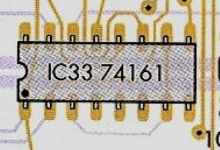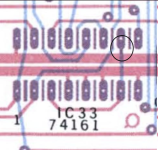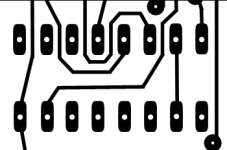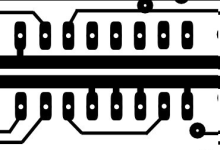daver2
10k Member
Although I already have the Rev C schematics as a single page for each board?
Dave
Dave
Thanks for the offer! Just purchased some yesterday, but have a few more I wasn't able to find decent deals on yet - here is what I still need with qty's:Nullvalue, if you get to the point of thinking the issue might be the need for some vintage 74 series chips, please post a list of what you need. I salvaged many many lower numbered 74's (up to about 741xx) and ditto with some 74LS's. All of these are from 3 or 4 decades ago. Additionally, I once purchased a cabinet full of NOS EGC 74LS's off eBay, which was a surprise since I didn't even know Sylvania ever marketed 74LS series chips. So I'll hazard a guess that these were all remarked IC's from various brands. Note: some of the salvaged 74's may need some additional lead straightening or solder removal if my supply is limited.
What you missed out is posting a photograph when D5=1. You did say that the pulsing doubled (which it is supposed to do) but there are some interesting artefacts that are supposed to occur with the pulse spacing.
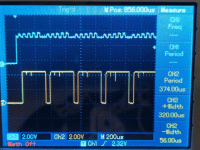

IC32 & 33 pin1 are both high.I would concentrate on IC32 and IC33.
Both ICs should have pin 1 (/CL) HIGH. This comes from the external SYNC input (that should have a shorting link inserted) and via IC36 pins 1 and 2. If we see any low-going pulses here, we are in trouble...
Yes I have 3.59 clock signal on both pin 2's.Likewise, both ICs should have pin 2 (CK) fed from our 3.58 MHz clock.
I have the 16KHz clock on both pin 9's. D5=0/1 doesn't affect these pinsThe only other common input pin to these ICs is pin 9 (/L). It would be interesting to see what is on this pin with both D5=0 and D5=1.
After that, we will be looking at the A, B, C and D outputs from ICs 32 and 33.
When the /L pin is LOW, the outputs should be preset to ABCD = 1000.
When the /L pin is HIGH, IC 32 and 33 should count up from the initial value of 1000. The carry from IC 33 should count +1 into IC 32.
One possibility is that /L is prematurely loading IC 32 and IC 33. In this case we have to work our way back in the logic.
The other possibility is a faulty IC32 or IC33.
The other possibility is faulty logic gates that 'merge' the pulses generated from IC32 and IC33.
If it was me, I could see myself using IC32 pin 9 (/L) as a trigger for the oscilloscope and then having a poke around the outputs from IC32/33 and the resultant logic (toggling D5) to see what is going on. The logic gates are quite simple (AND and OR gates) so there should be no problem in looking for inputs that do not work as expected.
Can you stick the oscilloscope probe on IC33 A, IC33 B and IC32 A please to see what we have in terms of frequency and high/low voltage.
Ok sorry so pin 14=A,13=B,12=C,11=D?Are you measuring the A input or A output?
I am meaning the output...
Dave
Are you saying pin 3 should be tied high? I do not see that on the foils or the PCB.Check that pin 3 of both IC32 and IC33 has a PCB track to +5V though.
I do not see that on Hugo's drawings for pin 10 or on this foil - am I looking at the wrong thing?I can see it on the red/blue foils in the manual (just).
IC33 pin 3 is connected to pin 7 which is connected to pin 10 which is then connected to the nearby +5V rail.
IC33 pin 10 should have a PCB track on both the red and blue sides (i.e. both sides) of the PCB.
Check the voltage readings on IC33 pins 7 and 10 as well. We may be missing a short segment of PCB track?
Dave
